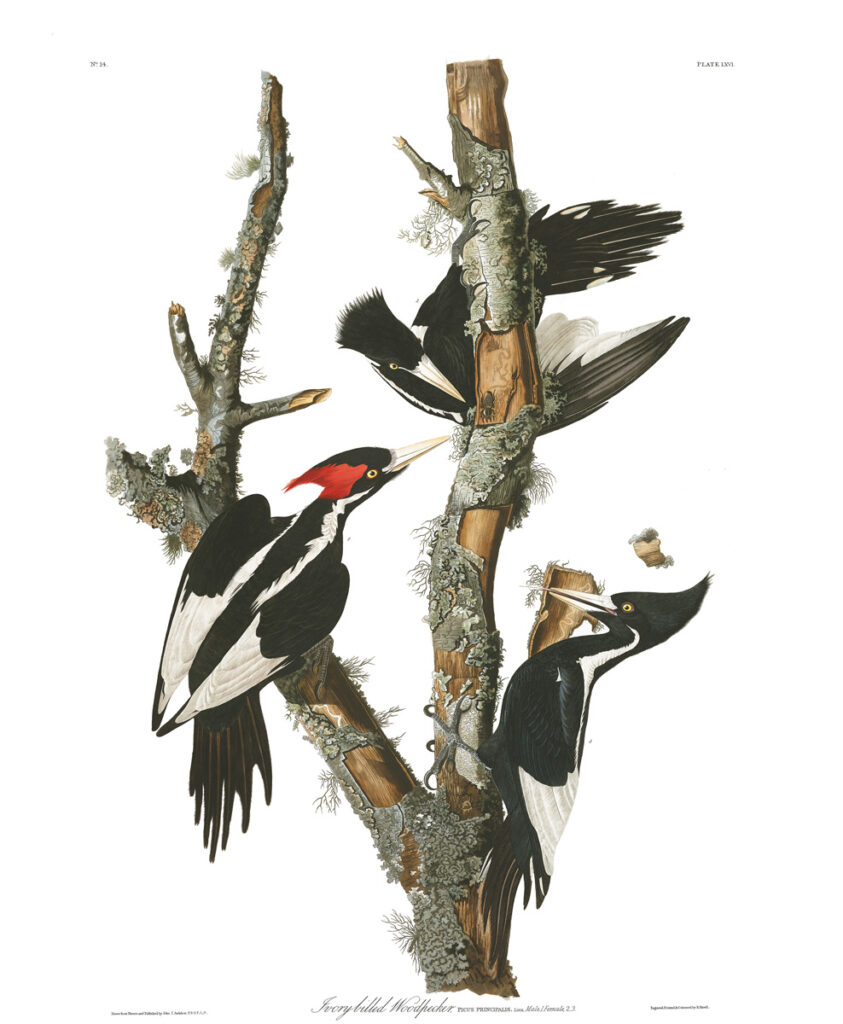
In Memoriam: The Lord God Bird, an American Symbol
On September 29, the US Fish and Wildlife Service declared 23 species as officially extinct. Eleven species of birds were among them. The most noted was the Ivory-Billed Woodpecker, native to the southeastern US and Cuba. The last confirmed sighting of the woodpecker in the US was in Louisiana in 1944, and in Cuba in 1987. Habitat destruction and hunting were cited as the primary causes of extinction.
The species was largely thought to be extinct by the 1920s, with heavy logging and plume collecting during the late 18th century, decimating their habitat and population. An ornithologist found a nesting pair in Florida in 1924, and in 1932 a Louisiana state representative shot one and brought it to his state wildlife office. This began a Louisiana expedition that discovered a population of the woodpeckers in Singer tract, an untouched “old growth forest,” which had survived untouched for centuries and developed a unique ecosystem. It was named after its owner, the Singer Sewing Company, who had already sold logging rights to the land.
This began a mad struggle against time and greed to preserve what was the only known remaining habitat of the Ivory-Billed Woodpecker, a story chronicled in the recently released Ghost Birds: Jim Tanner and the Quest for the Ivory-billed Woodpecker, 1935-1941. Jim Tanner himself traveled through 45,000 miles of the southeast, trying to find any remaining habitat besides the Singer tract. His search was fruitless.
There was a brief moment of hope for the bird; the National Audubon Society offered to purchase land within the Singer tract, home of these birds. Jim Tanner held a meeting with an executive of the logging company Singer had sold the rights to. He showed evidence of the woodpecker living where logging was scheduled. Tanner noted that this executive showed some interest in cooperation, but said, of the trees the birds depended on for food, “they ought to learn to feed on something different.” Many of the loggers who would have cut down these trees went overseas in WWII, offering a brief reprieve to the birds before the U.S. government began importing German POWs by the thousands to log trees for telephone poles, roads, and crates to ship tea back to Britain.
The bird was the largest in its range, sporting a body over 20 inches long and with a wingspan of 2.5 feet. Males could easily be spotted by their bright red plumage. Jim Tanner noted the bird preferred to dwell in light, saying “it lives in the sun… in surroundings as bright as its own plumage.” Before the founding of the US, multiple indigenous tribes used the woodpecker’s beak for ceremonial pipes, amulets, and headbands. Thomas Jefferson named it a “larger red-crested woodpecker” in his Notes On the State of Virginia (1785).
“Lord God Bird” was the moniker given it by Theodore Roosevelt after he observed people shouting “Lord God, what a bird!” as it swooped overhead in a flash of black and white. Naturalist and ornithologist John James Audubon, who painted 435 species in exquisite detail in his masterwork The Birds of America (and the namesake of the Audubon Society), counted it as his personal favorite. Grammy-nominated recording artist Sufjan Stevens has immortalized the Ivory-Billed Woodpecker in his song The Lord God Bird, based on an unconfirmed sighting in Brinkley, Arkansas in 2004. The bird quickly became a symbol of hope for a small town devastated by a recession and population loss, with wooden cutouts of the birds popping up all across town and the local burger joint dubbing their new special “The Ivory-Billed Woodpecker.” The executive director of Brinkley’s Chamber of
Commerce called it a “resurrection”—not just for the bird, but for the stagnant local economy.
The reverence for this bird went past its nickname; it has been a symbol of hope for ornithologists since the 1800s that humanity could never truly destroy a species, that we could never kill the “Lord God Bird.” The 2004 sighting invigorated a new sense of hope that it could still be out there, that we had failed to wipe it out, and that there would be hope for our own species as well.
There are more than 500 species of birds in New Mexico alone, and we still have the opportunity to see them and protect them for future generations. You don’t have to travel far to see some of our own woodpeckers: the Downy Woodpecker can be found year-round at Cimarron Canyon State Park, and Hairy Woodpeckers can usually be found in wooded backyards or pine forests. The more rare Lewis Woodpecker, which resembles a large hummingbird with its shiny green back and bright pink chest, will visit suet feeders around the Questa area. I can testify they especially love peanut suet; coating a pinecone in peanut butter, then rolling it in seeds is a great way to attract them. As always, remember to log sightings with the free eBird app to provide critical information for ornithologists. https://ebird.org
You can listen to the ivory-billed woodpecker’s song by going to All About Birds from the Cornell Ornithology Lab https://www.allaboutbirds.org/guide/ivory-billed_woodpecker
Author
-

Bryce Flanagan moved from Sacramento, CA to Taos County in 2016, and has lived in Questa for two years. He's passionate about the unique and beautiful wildlife of our state and is a regular contributor to the Questa Del Rio News.
View all posts



